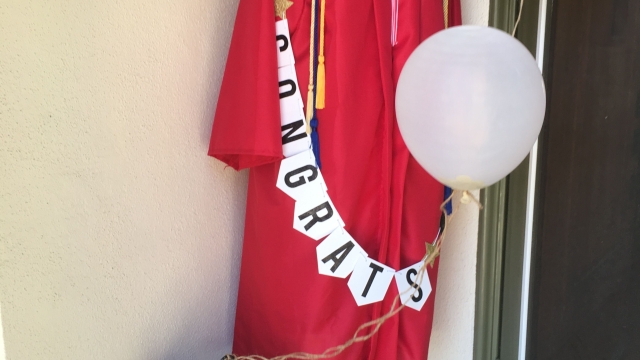Graduation day is a momentous occasion filled with a sense of accomplishment and anticipation for what lies ahead. Among the various traditions that make this occasion so memorable, one of the most iconic is the donning of graduation caps and gowns. These timeless symbols play a significant role in marking the transition from student to graduate, embodying the years of hard work, dedication, and growth experienced throughout one’s academic journey.
The graduation cap, also known as the mortarboard, with its square shape and tassel suspended from the top, carries with it a deep-rooted symbolism. It represents the culmination of knowledge and the attainment of a higher level of education. As graduates proudly toss their caps into the air at the conclusion of the ceremony, it signifies the release of their intellectual achievements into the world, ready to make their mark and contribute to society.
Similarly, the graduation gown holds its own symbolism and history. Originally derived from the attire worn by medieval scholars, the gown signifies the academic roots of higher education. Its flowing fabric and distinct embellishments serve as a visual representation of the prestige associated with obtaining a degree. When graduates walk across the stage, the swish of their gowns echoes the achievements they have made and the strides they have taken to reach this milestone.
Together, graduation caps and gowns create a sense of unity and tradition among graduates, connecting generations of scholars who have come before and those who will follow. They serve as a visual reminder of the transformative power of education and the incredible journey that leads to graduation day. So, as we witness the turning of tassels and the donning of caps and gowns, let us celebrate the significance of these symbolic garments and the remarkable accomplishments they represent.
History of Graduation Caps and Gowns
In ancient times, the tradition of wearing caps and gowns during graduation ceremonies was not existent. Scholars and students commonly wore their everyday clothing during important academic events. It wasn’t until the Middle Ages that the distinctive attire we now associate with graduations began to emerge.
The origins of the graduation cap, also known as the mortarboard, can be traced back to the square head-coverings worn by medieval scholars. These early caps symbolized their status as intellectuals. Over time, the cap evolved into the recognizable shape we see today, with its distinct flat top and tassel that hangs from a button.
The gown, on the other hand, reflects the attire worn by religious leaders and clergy members in the medieval period. Scholars donned similar flowing robes to signify their commitment to knowledge and education. The use of gowns during graduation gradually spread to educational institutions around the world, becoming a symbol of academic achievement and scholarly pursuit.
As time passed, the graduation cap and gown tradition became firmly ingrained in academic culture. It signified the transition from student to graduate, marking the culmination of years of hard work and dedication. Today, these iconic symbols of graduation evoke a sense of pride, accomplishment, and the pursuit of knowledge that continues to endure in modern educational ceremonies.
Meaning and Symbolism
Graduation caps and gowns hold significant meaning and symbolism in the world of academia. They are not merely garments worn during the commencement ceremony; they represent a long-standing tradition and the culmination of years of hard work and dedication.
The graduation cap, also known as the mortarboard, is perhaps the most recognizable symbol of graduation. Its square shape, adorned with a tassel, is steeped in history and tradition. The cap symbolizes the attainment of knowledge and the completion of an educational journey. As students move their tassels from one side to the other during the ceremony, it signifies the transition from student to graduate.
The gown, worn by both male and female graduates, carries its own symbolism. Traditionally, graduation gowns were black, symbolizing formality and seriousness. However, different institutions and fields of study may have their own designated colors, imparting further significance to the gown. Regardless of color, the gown embodies equality among graduates, representing the unity of academic achievement.
In addition to their individual meanings, graduation caps and gowns also serve a symbolic purpose as a collective representation of the academic community. They create a sense of camaraderie among graduates and link them to a long line of scholars who have come before them. As graduates don their caps and gowns, they become part of a proud lineage, connected by knowledge, achievement, and intellectual pursuits.
In conclusion, graduation caps and gowns hold immense meaning and symbolism. They symbolize the academic journey, the attainment of knowledge, and the unity of graduates across different disciplines and institutions. Donning these garments during commencement signifies the transition from student to graduate, as well as the pride and honor associated with completing one’s educational pursuits.
Choosing and Wearing Graduation Attire
When it comes to choosing and wearing graduation attire, there are a few key points to keep in mind. First and foremost, ensure that the gown you select is the appropriate color for your field of study. Different academic disciplines often have designated colors, so it’s important to represent your area of expertise correctly.
In addition to color, it’s crucial to pick the right size for your graduation gown. You want to achieve a comfortable fit that allows you to move freely and confidently during the ceremony. Take accurate measurements of your height and chest width to ensure that you select the right size from the available options.
Once you have chosen the perfect gown, it’s time to focus on the graduation cap, also known as the mortarboard. Make sure the cap is adjusted properly to sit comfortably on your head. It should be worn parallel to the ground, with the tassel falling on the right side before the official tassel-turning moment.
Masters Graduation Gowns

Remember that graduation attire is not just an outfit, but a symbol of your achievements and hard work. Take pride in wearing it as you walk across the stage to receive your well-deserved diploma. Congratulations on reaching this milestone in your academic journey!


